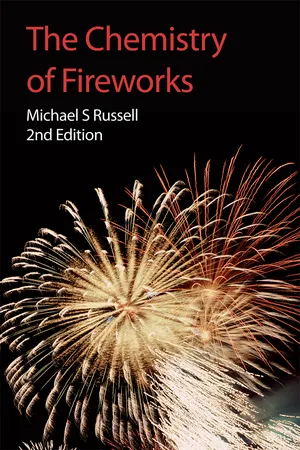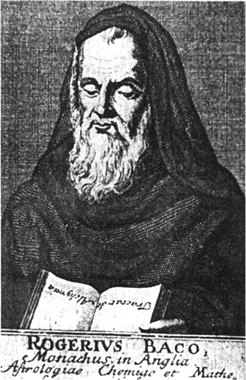![]()
CHAPTER 1
Historical Introduction
EARLY INCENDIARY DEVICES
Working with fire probably began about half a million years ago when patriarchal cavemen realised that they felt the cold and began rubbing pieces of wood together until the friction caused an ignition. In fact, it is none too easy to generate fire in this way but we have all seen contrivances driven by coils of leather that spin a pointed stick against a wooden notch until it smokes and eventually bursts into flame.
Now it was originally thought that fire was a kind of substance and that this substance generated flames when it met the air. It is only within the last 200 years or so that fire was correctly interpreted as being a form of energy where the flames are defined as regions of luminous hot gas.
To find evidence of the first application of fire in the creation of ‘special effects’ it is necessary to go back some 1400 years when the naturally-occurring substances petroleum and naphtha were employed by the Greeks as an early form of napalm. In the characteristically unfriendly practices of those times, one Kallinikos from Heliopolis of Syria set forth in armed conflict against the Arabs. He had equipped fast-sailing galleys with cauldrons of what amounted to burning crude oil and proceeded to set the boats of the enemy ablaze, with the men still aboard. The incendiary was called ‘Greek Fire’.
The ploy must have worked because the subsequent narrative tells us that the Byzantines then capitalised on their secret weapon by the wholesale destruction of the Moslem fleet at Cyzicus and continued to win naval battles in this way for several centuries afterwards.
DEVELOPMENT OF BLACK POWDER
By about the eighth century AD, Chinese alchemists, amongst others, were preoccupied with discovering the elixir of life. Concoctions were made containing all manner of substances including oils, honey and beeswax, but among the most significant, so far as future firework makers were concerned, were the ingredients sulfur and saltpetre. Unbeknown to the ancients, their brew of honey, sulfur and saltpetre (potassium nitrate) was special in that, on evaporation over heat, the contents would suddenly erupt into a wall of flame. By chance, the experimenters had produced the exact proportions by which the molten sulfur and what was left of the honey were acting as fuels that were subsequently oxidised by the oxygen from the potassium nitrate in what is now known as an ‘exothermic chemical reaction’, and a fairly vigorous one at that! In purified form, the chemicals sulfur and saltpetre are used to this day in what is without doubt the most important tool of the firework makers, i.e. gunpowder.
These dangerous early experiments led to many secret or banned recipes, but enough information was disseminated to enable the details of the discovery to be brought to Europe. However, the place and date of the invention of true gunpowder are still unknown and have been the subject of extensive but inconclusive investigation.
Once the reactive tendencies of potassium nitrate were unleashed it was simply a matter of time before the third vital ingredient, charcoal, was added to complete the famous gunpowder recipe of charcoal, sulfur and potassium nitrate. Needless to say, much time and effort were expended before the alchemists produced a successful product.
As with many notable inventions, the credit for the discovery is usually coloured by patriotism, each country putting forward its own ‘inventor’. What is significant, however, is that by about 1000 AD the Chinese were using a propellant similar to gunpowder in crude forms of rockets (Flying Fire), together with grenades and even toxic smokes. For example, a recipe in the Wu Ching Tsung Yao dated 1044 describes a mixture containing sulfur, saltpetre, arsenic salts, lead salts, oils and waxes to give a toxic incendiary that could be launched from a catapult.
More peaceful uses of these crude articles appeared in the form of ‘fire crackers’ – the first fireworks? One mixture corresponded quite closely to modern gunpowder in that it contained saltpetre, sulfur and willow charcoal. The ‘fire cracker’ was said to consist of a loosely-filled parchment tube tied tightly at both ends and with the introduction of a small hole to accept a match or fuse. All of these incendiary mixtures, presumably containing saltpetre, are mentioned in Chinese work dating from the eleventh century AD. Thus, in theory at least, the Battle of Hastings could have been one of ‘Greek Fire’, incendiary rockets and grenades.
Skipping about two centuries, the activities of one experimenter typify the development of early black powder. His work took place between about 1235 and 1290 AD and he is reputed to have been the first scholar in Northern Europe who was skilled in the use of black powder. In essence, his work provided the backbone of all early chemical purification and formulation, without which the development of true gunpowders would not have been possible. His name was Roger Bacon (Figure 1.1).
Born in about 1214, Bacon became a monk but was educated at Oxford before gaining a doctorate in Paris. His subjects included philosophy, divinity, mathematics, physics, chemistry and even cosmology. He carefully purified potassium nitrate (by recrystallisation from water) and went on to experiment with different proportions of the other two ingredients (sulfur and willow charcoal) until he was satisfied that,
By the flash and combustion of fires, and by the horror of sounds, wonders can be wrought, and at any distance that we wish, so that a man can hardly protect himself or endure it.
Of course, ‘The Church’ was not wildly enthusiastic with the prospect of one of its disciples practising such fiendish alchemy, and Bacon served ten years’ imprisonment. But he preserved his most famous recipe of ca. 1252 AD in the form of an anagram, which on deciphering reads ‘of saltpetre take six parts, five of young hazel (charcoal) and five of sulfur and so you will make thunder and lightning’. In percentage terms, the 6:5:5 formula translates as saltpetre 37.50 parts by weight, charcoal 31.25 and sulfur 31.25 parts.
In fact, Roger Bacon’s formula was not too dissimilar from early Chinese recipes. But being natural products, all three ingredients were of variable purity. For example, the crude Indian or Chinese saltpetre was richer in true saltpetre than the European material, but all required recrystallisation. The preferred process seems to have involved wood ashes, containing potassium carbonate, which precipitated deliquescent calcium salts from the saltpetre solution. The solution was then passed through a filter, boiled to reduce the volume of water and then left until the transparent plates of purified saltpetre were formed.
Sulfur occurs widely in nature as the element and was thus easily obtainable by the ancients. The Chinese had rich natural deposits, and the substance is readily purified by sublimation, a process in which the native sulfur is heated and the evolved vapour collected directly as a pure solid.
Charcoal was made from common deciduous woods such as birch, willow or alder, the last two being preferred.
The wood is simply carbonised at relatively low temperatures in a restricted air supply to form an amorphous, quasi-graphitic carbon of very fine particle size. Although of reasonably high purity, it is the enormous surface area per unit mass of the charcoal which makes it very adsorbent to water vapour, and this property is conferred to the black powder mix, as Roger Bacon would have soon realised.
Guns were invented shortly after Bacon’s death in about 1292 and so he never used the term ‘gunpowder’. However, he had certainly had experience of fireworks for which his early black powder recipe would have been perfectly suitable. In the Opus Majus he wrote:
We have an example of this in that toy of children which is made in many parts of the world, namely an instrument as large as the human thumb. From the force of the salt called saltpetre so horrible a sound is produced at the bursting of so small a thing, namely a small piece of parchment that we perceive it exceeds the roar of sharp thunder, and the flash exceeds the greatest brilliancy of the lightning accompanying the thunder.
In experimenting with fireworks, Roger Bacon and other medieval chemists discovered that a loose, open tray of powder was all that was needed to produce a flash, but in order to produce the bang the powder needed to be confined, and this has great significance. And even with his unbalanced 6:5:5 formula, Bacon was able to deduce these fundamental ballistic effects.
This short introduction to gunpowder would not be complete without reference to its final development and one or two subsequent events that were to change the course of history.
In lighting a firework we are going back at least 1000 years. The potassium nitrate in the blue touch-paper or the match burns in much the same way as it did when the Arabs or the Chinese played with their fire crackers. The smell of the sulfur when it forms hydrogen sulfide on combustion would have been much the same, as would the dense white smoke that is so characteristic of gunpowder. But modern fireworks are reliable products. The gunpowder has a consistent burning rate and is less affected by moisture than it would have been in the eleventh century. Obviously it was in the interests of the future markets that the experimenters persevered, and their pioneering work was by no means trivial.
First, true gunpowder is not just a ‘loose’ mixture of unground potassium nitrate, sulfur and charcoal. Indeed, if the three ingredients are mixed in this way then a greyish powder results that is almost impossible to light. If ignition does occur the burning is fitful ...

